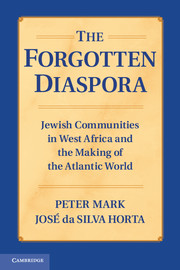Book contents
- Frontmatter
- Contents
- List of Illustrations
- Acknowledgments
- Introduction
- 1 Two Sephardic Communities on Senegal's Petite Côte
- 2 Jewish Identity in Senegambia
- 3 Religious Interaction
- 4 The Blade Weapons Trade in Seventeenth-Century West Africa
- 5 The Luso-African Ivories as Historical Source for the Weapons Trade and for the Jewish Presence in Guinea of Cape Verde
- 6 The Later Years
- Conclusion
- Appendix I The Jewish Traders of Porto d'Ale and Joal, Their Relatives, and Some of Their New Christian Partners in Senegambia and in the United Provinces and Portugal: A Comprehensive List (ca. 1606–ca. 1635)
- Appendix II A Chronological Outline of the Institutional Proceedings against the Jews of Porto d'Ale and Joal (1611–1643)
- Bibliography
- Index
5 - The Luso-African Ivories as Historical Source for the Weapons Trade and for the Jewish Presence in Guinea of Cape Verde
Published online by Cambridge University Press: 03 May 2011
- Frontmatter
- Contents
- List of Illustrations
- Acknowledgments
- Introduction
- 1 Two Sephardic Communities on Senegal's Petite Côte
- 2 Jewish Identity in Senegambia
- 3 Religious Interaction
- 4 The Blade Weapons Trade in Seventeenth-Century West Africa
- 5 The Luso-African Ivories as Historical Source for the Weapons Trade and for the Jewish Presence in Guinea of Cape Verde
- 6 The Later Years
- Conclusion
- Appendix I The Jewish Traders of Porto d'Ale and Joal, Their Relatives, and Some of Their New Christian Partners in Senegambia and in the United Provinces and Portugal: A Comprehensive List (ca. 1606–ca. 1635)
- Appendix II A Chronological Outline of the Institutional Proceedings against the Jews of Porto d'Ale and Joal (1611–1643)
- Bibliography
- Index
Summary
Objects of material culture are documents of their time and place. Artifacts, just as much as written sources, provide information and insight into historical events. In addition, they serve as graphic evidence of contact among different cultures, illustrating trade networks and shedding light on the accompanying exchange of technology and even of ideas. Images, and the symbolism that they encompass and express, may give voice to concepts and even to beliefs that are not readily committed to or expressed in writing. The object, when situated and interpreted within the specific cultural and historical context that engendered it, complements and enriches the study of more traditional historical documents such as travel narratives and archival records. Material culture therefore can be crucial to the study of the history of cultural and religious interaction.
Today approximately 150 artworks have been identified by scholars as belonging to the “corpus” of carved ivories from West Africa. Although they are usually referred to as “Afro-Portuguese” ivories, these pieces are more appropriately referred to as Luso-African ivories. The latter term reflects their creation by West African sculptors working within Africa. The objects, although hybrid in inspiration, are far more African than Portuguese. No documentary evidence exists to indicate that any of the ivories were carved by African artists living in Portugal. West African artists created the sculptures within the context of their own cultures.
- Type
- Chapter
- Information
- The Forgotten DiasporaJewish Communities in West Africa and the Making of the Atlantic World, pp. 135 - 158Publisher: Cambridge University PressPrint publication year: 2011
- 1
- Cited by



